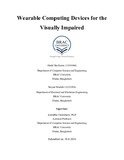| dc.contributor.advisor | Chakrabarty, Amitabha | |
| dc.contributor.author | Karim, Shakil Bin | |
| dc.contributor.author | Mustafa, Nayyar | |
| dc.date.accessioned | 2016-09-20T05:47:34Z | |
| dc.date.available | 2016-09-20T05:47:34Z | |
| dc.date.copyright | 2016 | |
| dc.date.issued | 8/10/2016 | |
| dc.identifier.other | ID 13201068 | |
| dc.identifier.other | ID 12221056 | |
| dc.identifier.uri | http://hdl.handle.net/10361/6421 | |
| dc.description | Cataloged from PDF version of thesis report. | |
| dc.description | Includes bibliographical references (page 92-94). | |
| dc.description | This thesis report is submitted in partial fulfillment of the requirements for the degree of Bachelor of Science in Computer Science and Engineering, 2016. | en_US |
| dc.description.abstract | This thesis is about creating a prototype of wearable computing devices that possess the ability to aid the mobility of the visually impaired. The devices are a belt and a pair of shoes which are connected via Bluetooth to a smartphone running an application built specifically for these devices. The belt consists of ultrasonic and infrared sensors for obstacle and hole detection from waist level, and coin vibration motors for providing haptic feedback. When in a difficult situation the user can send for help at the press of a switch on the belt which will make use of its Bluetooth connectivity to the smartphone to transmit the signal to dear ones in the form of a phone call and a push notification. The GPS of the phone will enable the location of the sender to be sent as well along with the help signal in the form of a push notification. The shoes, like the belt, contains ultrasonic sensors for obstacle detection and coin vibration motors for the haptic feedback. But it also comprises of a pulse rate sensor that can measure pulse rate of the user (as taken from the dorsalis pedis artery underneath the top mid surface of the foot) and via Bluetooth connection with the smartphone have it transmitted live to dear ones. If the pulse rate becomes abnormal the application will be able to send help signals to dear ones even if the user did not have the opportunity to press for help. | en_US |
| dc.description.statementofresponsibility | Shakil Bin Karim | |
| dc.description.statementofresponsibility | Nayyar Mustafa | |
| dc.format.extent | 94 pages | |
| dc.language.iso | en | en_US |
| dc.publisher | BRAC University | en_US |
| dc.rights | BRAC University thesis are protected by copyright. They may be viewed from this source for any purpose, but reproduction or distribution in any format is prohibited without written permission. | |
| dc.subject | Wearable computing | en_US |
| dc.subject | Coin vibration motor | en_US |
| dc.subject | Pulse rate sensor | en_US |
| dc.subject | Android studio | en_US |
| dc.title | Wearable computing devices for the visually impaired | en_US |
| dc.type | Thesis | en_US |
| dc.contributor.department | Department of Computer Science and Engineering, BRAC University | |
| dc.description.degree | B. Computer Science and Engineering | |

